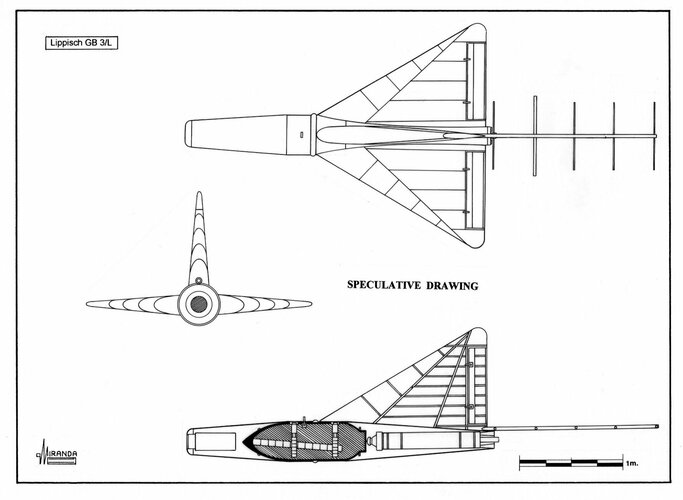The GB 3/L was a glide bomb project based on the aerodynamic solutions developed for the Lippisch P.12 by the Deutsche Forschungsanstalt für Segelflug.
Designed in July 1944 to compete against the antiship missile Henschel Hs 293D, it could transport a warhead of 250 kg at 800 km/h and reach a mobile target located 5 km away, with an error of just 6 m. This could be achieved thanks to its TV guidance system developed by Fernseh GmbH/Blaukpunkt. The TV transmitter Tonne worked on a frequency of 400 MHz, with an operating range of 150 km. Its measures were 40x17x17 cm and had a Zeiss Biogon lens of 35 mm focal length, a scan of 441 (vertical) lines at 25 pictures/sec, and 20 watts.
Together with the DEAG battery and the yagi antenna, the whole installation weighted 150 kg.
The missile was guided by a joystick and a Seedorf TV screen from the launch airplane, a Dornier Do 217 E. The glide range was of 5 to 15 km for a 1,000 to 7,500 m AGL release and speeds between 235 and 486 KTAS.
The tests for the Tonne/Seedorf system, made with Hs 293 D missiles between January and August 1944, proved the equipment unreliable and the project was cancelled.
Lippisch GB 3/L technical data
Wingspan: 2.2 m.
Overall length: 4.6 m.
Height: 1.3 m.
Wing area: 2.25 sq. m.
Launch weight: 550 kg.
Engine: one Rheinmetall-Borsig 109-502 Diglykol solid fuel rocket with 771 kg peak thrust.
Warhead: one SC 250 Minenbombe with 130 kg of Trialen 105 HE or 100 kg of Nipolit HE, without metal casing.
Fuse: ELAZ (38) B electric/impact operation.
Airframe: wooden and plywood with 100 kg structural weight.
Designed in July 1944 to compete against the antiship missile Henschel Hs 293D, it could transport a warhead of 250 kg at 800 km/h and reach a mobile target located 5 km away, with an error of just 6 m. This could be achieved thanks to its TV guidance system developed by Fernseh GmbH/Blaukpunkt. The TV transmitter Tonne worked on a frequency of 400 MHz, with an operating range of 150 km. Its measures were 40x17x17 cm and had a Zeiss Biogon lens of 35 mm focal length, a scan of 441 (vertical) lines at 25 pictures/sec, and 20 watts.
Together with the DEAG battery and the yagi antenna, the whole installation weighted 150 kg.
The missile was guided by a joystick and a Seedorf TV screen from the launch airplane, a Dornier Do 217 E. The glide range was of 5 to 15 km for a 1,000 to 7,500 m AGL release and speeds between 235 and 486 KTAS.
The tests for the Tonne/Seedorf system, made with Hs 293 D missiles between January and August 1944, proved the equipment unreliable and the project was cancelled.
Lippisch GB 3/L technical data
Wingspan: 2.2 m.
Overall length: 4.6 m.
Height: 1.3 m.
Wing area: 2.25 sq. m.
Launch weight: 550 kg.
Engine: one Rheinmetall-Borsig 109-502 Diglykol solid fuel rocket with 771 kg peak thrust.
Warhead: one SC 250 Minenbombe with 130 kg of Trialen 105 HE or 100 kg of Nipolit HE, without metal casing.
Fuse: ELAZ (38) B electric/impact operation.
Airframe: wooden and plywood with 100 kg structural weight.

